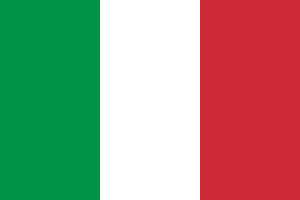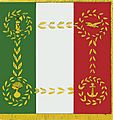Flag of Italy facts for kids
The flag of Italy is a famous symbol of the country. It is a three-color flag, often called the Tricolore (pronounced "tree-koh-LOH-ray") in Italy. It has three vertical stripes of the same size: green on the left, white in the middle, and red on the right. This design was officially adopted on January 1, 1948, when Italy became a republic.
Contents
The Italian Flag: A Symbol of Italy
The Italian flag is one of the most recognized flags in the world. It represents the history, culture, and spirit of the Italian people. Like many national flags, its colors have special meanings that tell a story about the country.
What Do the Colors Mean?
The three colors of the Italian flag are believed to have different meanings:
- Green often stands for the country's beautiful landscapes, like its hills and plains. It can also represent hope.
- White is usually seen as a symbol of the snow-capped Alps, Italy's tall mountains, and also represents faith.
- Red symbolizes the blood shed by those who fought for Italy's independence and unification. It can also represent charity.
These meanings help people remember the values and history of Italy every time they see the flag.
How the Flag Was Born
The idea for the Italian Tricolore came from the French flag during the time of the French Revolution. When Napoleon Bonaparte's armies came to Italy in the late 1700s, they brought ideas of liberty and new flags.
The first Italian flag with these three colors was created in 1797. It was used by a small republic in northern Italy called the Cispadane Republic. This happened in the city of Reggio Emilia, which is why this city is often called the "birthplace of the Tricolore."
The Flag and Italian Unification
For many years, Italy was not a single country. It was made up of many smaller states. In the 1800s, a movement called the Risorgimento (meaning "Resurgence" or "Rebirth") aimed to unite all these states into one nation. The green, white, and red flag became a powerful symbol for the people fighting for this unification.
Many heroes of the Risorgimento, like Giuseppe Garibaldi, fought under this flag. When Italy finally became a united kingdom in 1861, the Tricolore became its national flag. Later, when Italy became a republic in 1946, the flag kept its design, showing its strong connection to the country's long history.
The Strawberry Tree: A Natural Symbol
Did you know that a plant is also considered a national symbol of Italy because of its colors? The Strawberry tree (Arbutus unedo) has green leaves, white flowers, and red berries. These colors perfectly match the Italian flag, making it a natural representation of the nation.
Images for kids
-
The Sala del Tricolore, which later became the council hall of the municipality of Reggio Emilia, where the Italian flag was born on 7 January 1797
-
Tricoulor flag donated by the women of Milan to King Charles Albert of Piedmont-Sardinia during the First Italian War of Independence (1848–1849). It is displayed at the Royal Armoury of Turin.
-
The green leaves, white flowers and red berries of the strawberry tree, whose colours recall the flag of Italy: for this reason this bush is considered one of the Italian national symbols. The strawberry tree is the national tree of Italy.
-
The proclamation the Republic of San Marco in Venice (1848), event that was characterised by a waving of tricolour flags
-
The proclamation of the Roman Republic in Piazza del Popolo (1848) in Rome among a profusion of tricolour flags
-
Victor Emmanuel II of Piedmont-Sardinia and Napoleon III of France entered Milan during the Second Italian War of Independence (1859)
-
The departure of the Expedition of the Thousand (1860–1861)
-
Animated map of the Italian unification from 1829 to 1871
-
King Victor Emmanuel II of Italy entering Venice during the Third Italian War of Independence (1866) among a profusion of tricolour flags
-
Postcard of the Carabinieri sent from the Italian Eritrea in 1907 and depicting an eagle flying an Italian flag
-
Italian Argentines during the opening parade of the XXXIV Immigrant's Festival
-
Italian flag dating from World War I
-
A woman, representing Italy, celebrates the Italian victory over Austria-Hungary in World War I with a tricolour over the newly conquered city of Trieste
-
Il Canto degli Italiani and Goffredo Mameli remembered together with the period of the unification of Italy on a propaganda poster of the Italian Social Republic. In the background, a tricolour is waving
-
This Italian flag entered the Guinness World Records due to its length
-
The former President of the Italian Republic Carlo Azeglio Ciampi honors the flag of Cispadane Republic, first Italian flag, during the Tricolour Day on 7 January 2004 in Reggio Emilia
-
One of three original copies of Constitution of the Italian Republic, now in the custody of Historical Archives of the President of the Italian Republic
-
The Italian flag flying at the Altare della Patria, Piazza Venezia, Rome
-
The Italian flag flying on the top of the Quirinal Palace. From left to right, the Presidential Standard of Italy, the tricolour and the flag of the European Union
-
The Frecce Tricolori, with green, white, and red smoke trails, above the Altare della Patria in Rome
-
Solemn change of the Guard of honour of the Corazzieri Regiment at the Quirinal Palace in Rome on the occasion of the Tricolour Day on 7 January 2016
-
The Central Museum of the Risorgimento at Vittoriano, located in Rome
-
Interior of the Tricolour Flag Museum in Reggio Emilia, the city that saw the birth of the Italian flag in 1797
-
Comparison of the Italian and Mexican flags
See also
 In Spanish: Bandera de Italia para niños
In Spanish: Bandera de Italia para niños












































